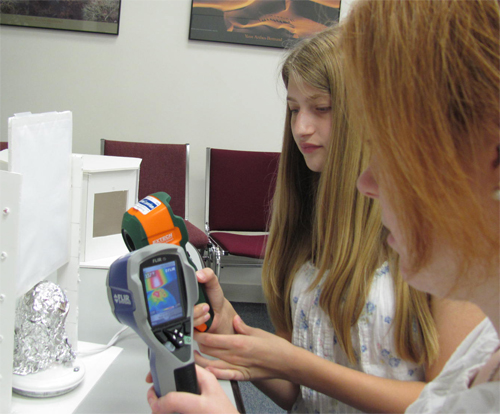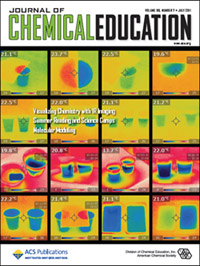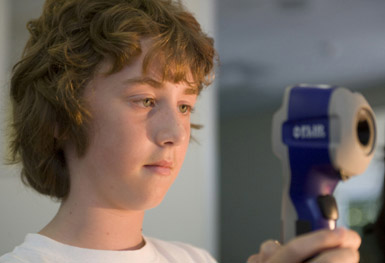Scientists Bring "Infrared Magic" to Classrooms
How an engineering technology becomes a learning technology
 The Concord Consortium's senior scientist Charles Xie recently earned a new title, "IR magician," from students, teachers, and colleagues.
Since 2010, Xie has been tirelessly telling the educational power of IR imaging through his blog posts, demonstrations, publications,
conference presentations, and teacher professional development workshops. His "IR magic" shows have been a smash.
The Concord Consortium's senior scientist Charles Xie recently earned a new title, "IR magician," from students, teachers, and colleagues.
Since 2010, Xie has been tirelessly telling the educational power of IR imaging through his blog posts, demonstrations, publications,
conference presentations, and teacher professional development workshops. His "IR magic" shows have been a smash.
IR imaging is a tool that can show the temperature distribution of a system based on detecting the invisible IR radiation it emits. A modern IR camera is an optoelectronic system made of thousands of tiny IR sensors, called microbolometers, behind a special optical lens that lets IR light through. It processes the electric signals from the microbolometer array and projects them onto a liquid crystal display screen to render intuitive thermal images that use different colors to represent different temperatures. Although IR imagers are not new, inexpensive handheld IR cameras that operate just like a digital camera have become available only recently. Thanks to the growing need for IR thermography in the industry and the advancement of technology, the price of an IR camera is now in the range of a few hundred dollars, such as the $249 FLIR ONE debuted at Consumer Electronics Show 2014 or the $199 Seek Thermal released eight months later.
"Scientists have long relied on powerful imaging techniques to see things invisible to the naked eye and thus advance science," explained Xie. IR cameras are one of the few scientific imaging tools that are easy to use—no complicated setup or calibration is needed. "This makes a perfect scientific instrument in classrooms—even a sixth grader can use it to discover something about science," Xie said. Few educators have explored the educational power of IR cameras, but Xie believes that the tool has tremendous potential in science and engineering education.

Image reprinted with permission from the Journal of Chemical Education. Copyright 2011. American Chemical Society.
"A picture is worth a thousand words. An IR image provides a lot of information about an experiment that can be rapidly recognized and absorbed by the human brain," Xie said. Salient, real-time thermal visualizations of invisible heat flow make the underlying concepts "speak for themselves" and can potentially offer superb laboratory experiences to students. What an IR camera can show and tell in no time would take students hours using traditional tools such as thermometers or sensors. According to Xie, "tedious cookbook-style procedures commonly found in our science laboratories are probably responsible for taking the fun away from science." By liberating students from laborious work, an IR camera can directly focus them on the core science.
Many people think IR imaging is just for home energy diagnostics or night vision. But its applications are far beyond those. In fact, it is a versatile tool that can be broadly useful across science disciplines. Many invisible physical, chemical, and biological processes that absorb or release heat can be visualized, discovered, and investigated using IR imaging. In principle, anything that leaves a trace of heat leaves a trace of itself under an IR camera.

A sequence of IR images showing the thermogenesis of a moth at the thorax.
"People are often surprised when I show them profound scientific effects in everyday life through an IR camera. To them, this is magic," said Xie. Most of his IR experiments are simple to set up and easy to do. One of his demonstrations involves only a piece of paper and a cup of room-temperature water. When the paper is placed on top of the cup, it appears red under an IR camera. Then the red color vanishes after a couple of minutes. If the paper is removed from the cup, its IR image becomes blue. Within only a few minutes, the color of the paper changes magically under an IR camera. "The heating of the paper is due to the condensation of water vapor from the cup onto its underside. With more and more water molecules condense, a thin layer of water forms. Then water molecules have to evaporate from that layer as well. When the evaporation of water from the layer counterbalances the condensation of water onto it, no net heat is released and the color disappears in the IR view. When the paper is removed, this dynamic equilibrium is broken. Water starts to evaporate from the layer, cooling down the paper. We calculate that the layer is as thin as a few hundred water molecules wide. If you are a chemist or materials scientist, this should sound familiar to you. It is actually an atomic layer deposition experiment that anyone can do," Xie explained.
Xie's lab is also working on uncovering the educational power of IR technology for visualizing unseen behaviors of plants and animals. "Many students have watched TV programs that show IR videos of animal or plant behaviors. It is now time to give this tool to students and let them explore science themselves," he added.

An IR imaging experiment that creates a "cognitive conflict" between visual and tactile inputs.
Xie's work has garnered attention from the science education community. His article "Visualizing Chemistry with Infrared Imaging" was selected as the cover article of the July 2011 issue of the Journal of Chemical Education [1]. It was described as "captivating, intriguing, and thought-provoking." [2] The Physics Teacher also published his work about applications of IR imaging to teaching physics as a featured article [3]. Prof. Robert Bucat at the University of Western Australia wrote in the 2015 book Chemistry Education: Best Practices, Opportunities and Trends that "Xie has opened up a new world of observation through infrared imaging to show the temperature distribution within systems" [4].
Meanwhile, Xie is collaborating with educational researchers Konrad Schönborn and Jesper Haglund at Linköping University in Sweden to conduct cognitive research that will hopefully shed some light on how IR visualizations affect laboratory learning. One of the research studies is based on a multisensory learning theory Xie proposed to remedy the notorious misconception that metals are colder than wood. A simple experiment was designed to create a "cognitive conflict" between visual and tactile inputs [5]: At the same time students feel that a knife is cooler than wood through touch, they see through an IR camera that the knife is actually getting warmer than wood. "How students reconcile this contradiction provides us rich data for analyzing what they think about heat and temperature. We hope to find a more effective treatment to make the misconception go away," said Xie.
The international collaboration with Linköping University was reported by Swedish newspaper Norrköpings Tidningar (which has about 50,000 subscribers) on September 30, 2011 in a front-page story titled with "Thermal cameras can become important in school physics." Jenny Sajjadi, a teacher in math and physics, was quoted as saying (translated from Swedish): "Physics is seen as an ‘old' subject and this is a bit of new thinking that can increase the students' interest. For me as a teacher, it is an entrance to deeper teaching."
Considering the importance of visualizations in science education, these pioneering studies will add a strong component to the field in an entirely new direction—real-time visualization of physical processes in the real world.
References:
[1] C. Xie, Visualizing Chemistry using Infrared Imaging, Journal of Chemical Education, 88, 881-885, 2011.
[2] E. K. Jacobsen and L. E. Slocum, Summer Camps, Journal of Chemical Education, 88, 849-850, 2011.
[3] C. Xie and E. Hazzard, Infrared Imaging for Inquiry-Based Learning, The Physics Teacher, 49, 368-372, 2011.
[4] Robert Bucat, Using the Cognitive Conflict Strategy with Classroom Chemistry Demonstrations, Chemistry Education: Best Practices, Opportunities and Trends, 2015, Wiley-VCH.
[5] K. Schönborn, J. Haglund, and C. Xie, Pupils' Early Explorations of Thermoimaging to Interpret Heat and Temperature, Journal of Baltic Science Education, 13, 118-132, 2014.
